KWin
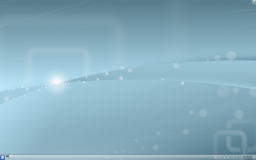 |
El gestor de ventanas seguro y flexible para los escritorios Plasma de KDE, ¡ahora con efectos! |
Descripción general de características
- Estable y seguro
- Composición, efectos 3D
- Fácil configuración
- Eficiencia mejorada
KWin (pronunciado "kwin") es el gestor de ventanas de KDE Plasma Desktop. Te da un completo control sobre tus ventanas, asegurándose de que no están en medio de tus tareas, sino ayudándote con ellas. Pinta la decoración de las ventanas, la barra superior de cada ventana con botones (configurables) como cerrar, maximizar y minimizar. También se ocupa de la colocación de las ventanas y del cambio entre ellas.
KWin es compatible con composición, que consiste en utilizar efectos 3D para manejar tus ventanas. Esto puede hacer que la gestión de ventanas sea más suave, fácil, eficiente y natural. Los requisitos de hardware son muy modestos y prácticamente todos los sistemas modernos desde 2002 son compatibles. Todavía hay algunos problemas con cierto hardware, puedes encontrar más información sobre esto en techbase
Características prácticas
Haz clic con el botón derecho en la decoración de una ventana o usa Preferencias del Sistema para acceder a la nueva y más sencilla configuración de KWin. Aquí puedes activar efectos para gestionar tus ventanas de forma más eficiente. Por ejemplo, puedes usar Presenta las ventanas como efecto para el cambio de ventanas. En lugar de mostrar iconos o previsualizaciones muy pequeñas de tus aplicaciones, las organiza en una red de forma que puedas elegir la adecuada rápidamente. Sólo tienes que usar las teclas Alt-Tab y mantener presionada la tecla Alt. Ahora puedes usar el tabulador para cambiar entre las ventanas o activar la correcta usando el ratón. Al presionar las teclas Alt-Tab rápidamente se mostrará la siguiente ventana en la cola, al igual que antes.
Si tu servidor X es compatible con composición, activarla es tan sencillo como abrir Preferencias del sistema, abrir el módulo , elegir y marcar la casilla . Configuraciones más avanzadas de la composición (como Usar VSync, Representación directa, tipo de composición) están disponibles en el diálogo . Para personalizar el comportamiento de los efectos de KWin abre la pestaña , y elige el plugin que quieras utilizar. Por favor, ten en cuenta que sólo un subconjunto de los plugins funciona con la composición XRender. Para una experiencia completa necesitas utilizar el modo OpenGL.
Employing motion physics, KWin provides your windows with a more natural feel. New desktop effects like the Cube desktop switcher and Magic Lamp minimize animation have been added. Improvements in the existing effects make window management smoother than ever. KWin has seen many performance improvements to enable these effects even on low-end hardware. Elaborate checks have been build in to ensure users with low-end hardware are not presented with an unusable setup. KWin detects the capabilities of the hardware and if needed gracefully scales its effects down. You can take control and disable these checks or change settings like the global animation speed to fine-tune your experience. When your computer is under heavy load, KWin will automatically disable the compositing temporarily to keep things running smoothly. It will notify you if it does so, and you can re-enable compositing by pressing Shift+Alt+F12. Finally, support for multiple screen handling has been improved in KWin using the new Kephal library. You can move maximized windows between Xinerama screens and the addition of external screens is handled correctly.
Más información sobre lo que se introdujo en KDE SC 4.2 se encuentre en el siguiente enlace:
Tutoriales
Quieres que una aplicación se inicie siempre con un tamaño y posición específicos
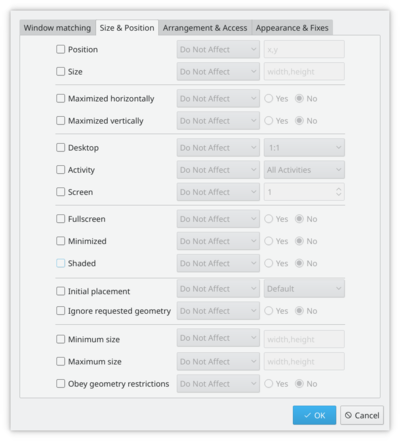
A veces la posición en la pantalla de una aplicación es vital para tu comodidad, así que usa la flexibilidad de KWin para asegurarte de que siempre esté donde tu quieras.
Coloca la ventana donde quieras que se abra, luego haz clic con el botón derecho en la barra del título, elige . Esto abrirá una ventana de configuración, con las entradas necesarias ya modificadas. Todo lo que necesitas hacer ahora es seleccionar la pestaña y marcar y . ¡Ya has acabado!
Script the window manager from the command line
Use the WMIface utility.
Customise the position of titlebar buttons
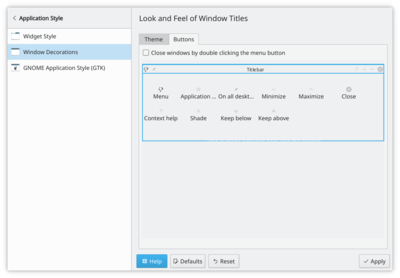
Take a look at tab - and enable . The options open to you may depend on your distribution or theme, and it's clear that there is more to come.
Perhaps you would like more space between the button and the pair? So you will want to add a - two if you wish.
To simply move things around you work with the speciman titlebar - that is the dark blue bar with a large KDE on it. Drag icons there and you will see them move in the preview window at the bottom of the screen.
You may find that you have other icons available to you. A circle indicates that the button will set that window on all desktops. Another icon that you may find useful is Shade - a toggle between rolled up (titlebar only visible) and normal view. These icons are added by dragging from the text description window onto the speciman title bar - just position them as you want to use them.
If you prefer a Classic, KDE3-style Desktop

|
| Change to traditional desktop |
Right-click on your desktop - select (or , in some distros). Change the from to . The whole desktop is now a folderview, and another right-click on the desktop will allow you to select . Set the folderview to the directory you want to use as your desktop.
A video of KWin features
A demonstration of features is here
Open applications directly into a different desktop
Use commands like
kstart --desktop 4 kate
Using with small screens (eg Netbooks)
Make the window decorations smaller
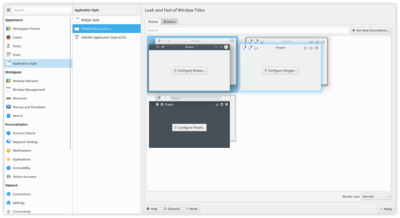
tab. Two good options there:
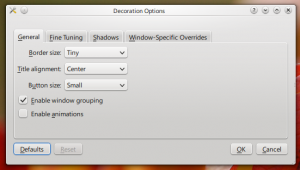
- Using the default style (Oxygen), select and set to and to
- Select the
Both routes will give you slim and functional window titles and borders.
Change the base fonts
On many netbooks the screen is very clear, so that reading fonts much smaller than you expect is feasible. On my Acer Aspire One I find that 8 point is a good base settings.
Make Firefox use smaller fonts
Experimentation with did not bring satisfactory results. Do this instead. Download and install gtk-chtheme from this website. Using that tool you can either set a specific font size, or better still, tell it to use your KDE desktop settings. This will work with Firefox as well as any gtk applications that you use.
KMail's Aggregation options take up too much space
See this FAQ to change it.
KMail's Folder-List Tooltips hide too many folder names
See this FAQ to change their behaviour
Gallery
The Gallery holds many screenshots of past and present desktops and effects.
